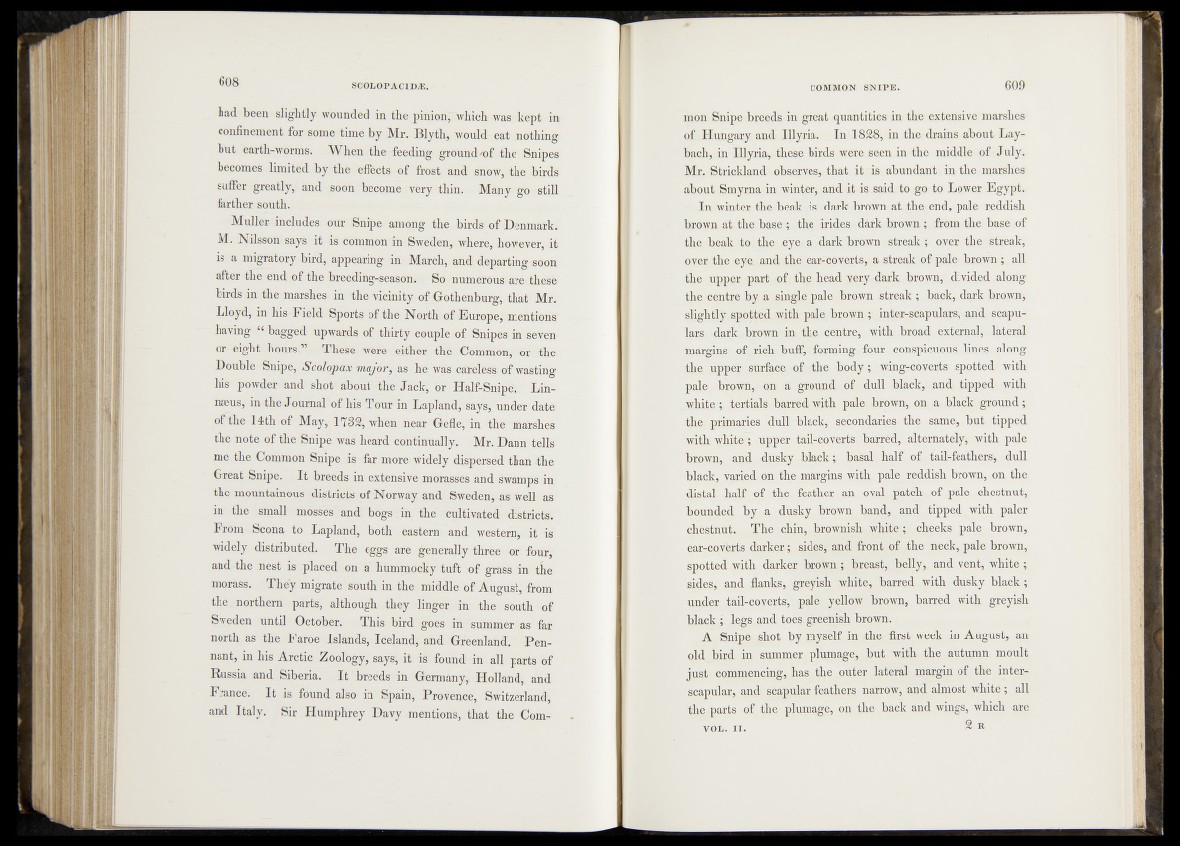
had been slightly wounded in the pinionTwhich was kept -in
confinement for some time by Mr. Blyth, would eat nothing
but earth-worms; When the-feeding ground *of the Snipes
becomes: limited by the effects of frost and snow, the birds
suffer greatly, and soon become very thin. Many go still,
farther south..
Mullet- includes pur Snipe among the birds of Denmark,
M. Nilsson says it is common in Sweden, where, however, it
is a migratory bird, appearing in March, and departing soon
after the énd of the breeding-season. So numerous are these
birds in the marshes in the vicinity of Gothenburg, that Mr.
Lloyd, in his Field Sports of the North; of Europe, mentions
having “ bagged upwards of thirty eouple^of Snipes inleven'
or eight hours.” These were Neither the Cömüió'n, or ffe-
' Double Snipe, Scolopax major? as he was careless, of wasting
Ms powder and shot about" the jafek; or Half-Snipe;. Linnaeus,
in the Journal of his Tour in Lapland, sayfif undekdatë’
of1 the 14th of May, 1782, when near Gefle, in the rmarshes
the note of the Snipe was heard continually. Mr. Dann tells
me the Common Snipe is far more widely dispersed than fhe
Great Snipe. I t breeds in extensive morasses and Swamps in;
the mountainous districts of Norway and Sweden, as well as
in the small mosses and bogs, in the cultivated districts.
From Scona to Lapland, both eastern and. western,., it is
widely distributed. The eggs are generally three or four,
and the nest is placed on a hummocky tuft of grass in the
morass. They migrate south in the middle of August, from
the northern parts, although they linger in the south of
Sweden until October. This bird goes - in summer as far
north as the Faroe Islands, Iceland, and Greenland. Pen- '
nant, in his Arctic Zoology, says, it is found in all parts of
Russia and Siberia. I t .breeds in Germany, Holland, and
France. I t is found also in Spain, Provence, Switzerland,
and Italy. Sir Humphrey Davy mentions, that the CommQf^
Smp.etl^e;gda ini great quantities; in-fhle extensive marshes
of IUyj-iav- In3T8$fhi|in the drains about Laybach,
4liyr<k .t.ihep,jb%ds^weret^Qentoh^he middle pf July.
Mr. Sladcklaad in the marshes
in win^e^and i t is said .to ge^tft Lower Egypt-,
- . In.iwilitl^tfie. beak:isv;dark: hrpwn;aft the end, pafe reddish
brown a t tbe(,h4se/; th^ irides dark, brown from the. base.of
tjm oyers-the. streak,
nv^T. t.hifAa^fei^)fn d.- the* ear-fe^jfefeka -.streakiof pale^Jarown § jfdjb
npp.§C pa A - A j t e h ead very« dark brown, divided, along,
the:cent|64|wAa. s i n d ^ p . a l e s c r e a k ;.5^bfek? dark browns,
sl.igh tlyy^ppfred -^yith t 1 )aloj,;b,|f o y ^
lars dafrk', brown dn^ffic^cbntrc. with^broa^ .exterhall lateral
margins formingcojgjighc^fions^ines along
the-, upper wing-coyej0 ;.spotted \ with
pale brown,. ground-, of dull black, and-tipped with
^i^ f.-^ tu r^ s^b a rre .d with pale brown, on a , b l a c k ground;
S ik primaries ^ullpjplack’, ' secondarirffhf .same, but tipped
with? whit,e^®|per >taii?'^d;\:.eEi^. barred.,, a lte r n a t e ly » ,p a l e
browm?1 and (3>nsk.v.-bMc'^^ basal half of^aff^feathersy^dull
With pale jredflfeh broM tefa the
half ^ofj t lp^.father ,an. oyal patch of pale chestnut,-
bounded^ ky, a d u s k y J b ^ ^m ^ ^ n d ^ n d ^ p p e ^w ith paler
ch;e;Stnut. The chin, broyrnisk pale brown,
ear-covelts. darker; sjdes; and ir.on-thpf |the -ptee^|ale; brown,
spotted with darker brown ;^b'rc;ast, b |||L , and vej®''white ^
sides, and flanks, .greyish J B ^ cLwith dusky black;,
p.nden.,jml^y Prtg,; pale vello.w^^pwn, barred with greyish
black ; l^gs^nd t.oes greenish brown.
A Snipe shot by mys1n£.jn the= first, week in August, an
old_J>ir,d in summer plumage, Jbut with,^he. autumn moult,
just commencing, has the o^fer^ lateral margin of the interscapular,
and scapular feathers narrow, and almost white; .all
the parts of the plumage, on^the back and wings, which are
VOL. I I . H R